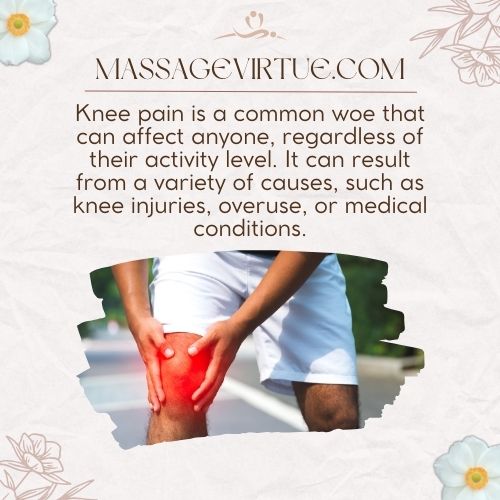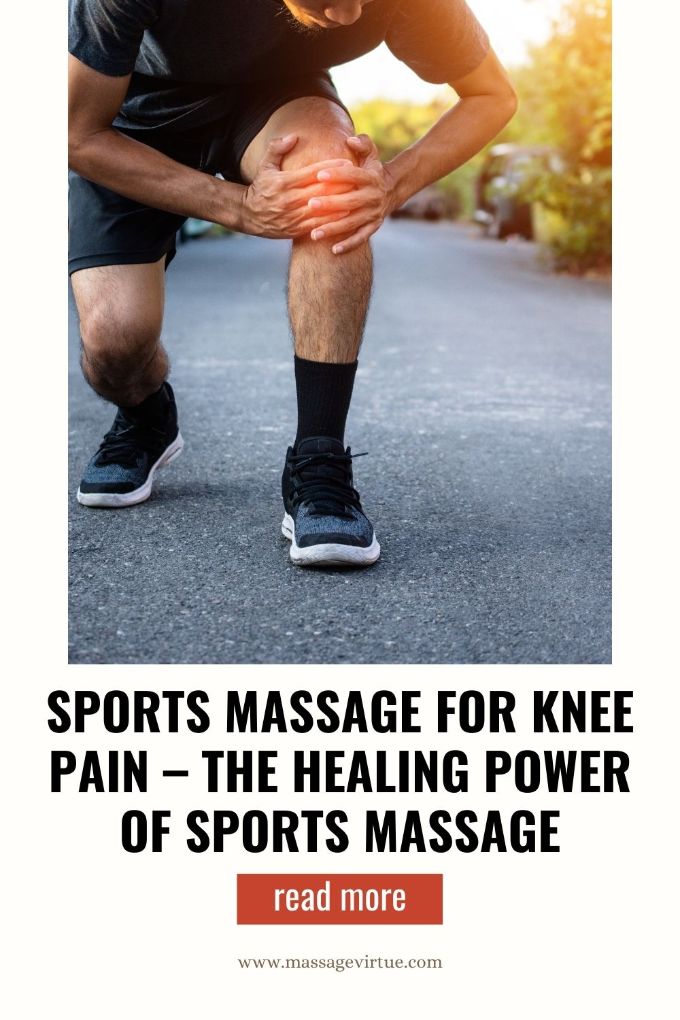Are you one of the countless individuals suffering from persistent knee pain? Whether you’re an athlete, a runner, or simply a sports enthusiast, knee pain can be a real hindrance.
The good news is that relief might be closer than you think, in the form of a sports massage for knee pain.
In this article, we will delve into the world of sports massage, exploring its benefits, techniques, and how to access this healing modality.
Let’s unlock the secrets to a pain-free and active life.
The Anatomy of Knee Pain
Knee pain is a common woe that can affect anyone, regardless of their activity level. It can result from a variety of causes, such as knee injuries, overuse, or medical conditions.
To address this issue, it’s essential to understand the knee’s intricate structure and the pain it can cause.
The knee is a complex joint connecting the thigh bone (femur) to the shinbone (tibia).

It’s supported by ligaments, tendons, and muscles, making it susceptible to injury and discomfort. Knee pain can hinder your mobility and quality of life, affecting daily activities, from walking to playing your favorite sport.
The Power of Sports Massage
Now, let’s explore how sports massage can be a game-changer for those suffering from knee pain.
Sports massage is a specialized therapeutic technique designed to target the muscles and soft tissues specific to your sport or physical activity.
It offers numerous benefits for pain relief and enhanced performance.
Benefits of Sports Massage for Knee Pain
Sports massage offers various benefits for knee pain. Let’s have a look at some of them:
1. Pain Reduction
Sports massage offers a highly effective solution for knee pain relief.
By alleviating muscle tension and enhancing blood circulation in the affected area, it facilitates a quicker return to your regular activities.
The sports massage enables you to reclaim your active lifestyle without the hindrance of persistent knee discomfort.
2. Injury Prevention
Regular sports massages serve as a proactive measure against knee injuries.
By maintaining muscle flexibility and balance, these massages are particularly valuable for athletes and active individuals, who often subject their knees to rigorous challenges.
3. Enhanced Recovery
Following intense workouts or sports activities, sports massages accelerate your recovery process.
They aid in the removal of metabolic waste products, curbing post-exercise soreness, and helping you bounce back faster.
4. Improved Range of Motion
Knee pain often imposes limitations on your movement.

Through its ability to break down adhesions and scar tissue, sports massage promotes enhanced joint mobility. It allows you for a broader range of motion.
5. Stress Relief
Knee pain can take a toll on your mental well-being.
Sports massage not only contributes to physical healing but also soothes your mind, mitigating the psychological impact of pain.
It provides holistic relief for a healthier, happier you.
Sports Massage Techniques
The efficacy of sports massage for knee pain hinges on the mastery of specific techniques that target the affected area with precision. Here are some notable sports massage techniques for knee pain relief:
- Effleurage: A gentle, gliding stroke over the knee area, aiding in improved blood circulation and relaxation of the surrounding muscles.
- Petrissage: Involves kneading and squeezing the soft tissues around the knee, facilitating the removal of metabolic waste and toxins.
- Friction: Focused pressure is applied to the knee joint to reduce scar tissue, and adhesions, and improve the mobility of the knee.
- Trigger Point Therapy: Targets specific points in the knee area that radiate pain, providing relief by releasing muscle knots and tension.
- Stretching: Gentle stretches to improve flexibility and enhance the range of motion, ensuring the knee remains agile and resilient.
How to Get a Sports Massage?
Now that you’re aware of the benefits and techniques, the next step is to understand how to get a sports massage for your knee pain. Here’s a step-by-step guide:
1. Find a Qualified Therapist: Start by researching licensed sports massage therapists in your area. Recommendations from friends or online reviews can be valuable resources.
2. Consultation: When you’ve identified a therapist, schedule a consultation. During this meeting, discuss your knee pain, its history, and your physical activity level. The therapist will create a treatment plan tailored to your needs.
3. The Massage Session: During the session, wear comfortable clothing that allows access to the knee area. You’ll communicate any discomfort or pain levels with the therapist to ensure a comfortable experience.
4. Aftercare: After your sports massage, your therapist may recommend ice, rest, or specific exercises to maximize the benefits of the treatment.
Sports Massage Tips For Knee Pain
| Tips | Description |
| Hydrate | Stay well-hydrated before and after your massage to flush out toxins and expedite recovery. |
| Communication | Openly communicate with your therapist about pain levels and concerns for a customized and comfortable experience. |
| Consistency | Maximize benefits with regular sessions, and discussing a treatment plan with your therapist to maintain your well-being. |
| Post-Massage Care | Adhere to therapist recommendations, including stretches and icing, for enhanced post-massage benefits. |
| Maintenance | Integrate sports massage into your regular wellness routine for proactive pain prevention and overall health. |
Conclusion
In summary, sports massage for knee pain is a remarkable solution for athletes, runners, and sports enthusiasts facing the daily challenge of knee discomfort.
Its benefits extend beyond pain relief, encompassing injury prevention, improved recovery, and enhanced mobility.
By following the steps to find a qualified therapist and understanding the techniques, you can take a significant stride toward an active and pain-free life.
FAQs
Will a Sports Massage Help Knee Pain?
Yes, a sports massage can help with knee pain. It’s a specialized therapy that targets the muscles and soft tissues around the knee.
It reduces muscle tension, improves blood flow, and promotes overall knee health.
So, it’s a valuable tool for pain relief and knee injury prevention.
Where Do You Rub for Knee Pain?
When dealing with knee pain, a qualified therapist focuses on the muscles and soft tissues around the knee joint.
They’ll use various massage techniques to alleviate tension, reduce inflammation, and improve circulation. It’s a precise and targeted approach to ease knee discomfort and promote recovery.


